
JOURNAL OF DERMATOLOGY
Scope & Guideline
Pioneering insights for a healthier tomorrow.
Introduction
Aims and Scopes
- Clinical Dermatology Research:
The journal emphasizes clinical studies that investigate various dermatological conditions, their treatment outcomes, and patient management strategies, ensuring relevance to practicing dermatologists. - Innovative Treatments and Technologies:
Research on emerging therapies, including biologics, JAK inhibitors, and novel drug formulations, is a core focus, reflecting the journal's commitment to advancing treatment options for skin diseases. - Epidemiological and Public Health Studies:
The journal publishes studies that assess the prevalence and impact of dermatological conditions in different populations, highlighting public health concerns and guiding healthcare policies. - Dermatopathology and Diagnostic Techniques:
There is a strong emphasis on the integration of histopathological findings with clinical presentations, as well as advancements in diagnostic technologies such as dermoscopy and reflectance confocal microscopy. - Psychosocial Aspects of Skin Disease:
The journal recognizes the importance of mental health and quality of life in dermatological conditions, publishing research that explores the psychosocial impacts of skin diseases on patients. - Diversity and Inclusion in Dermatology:
Research addressing the representation of skin of color and the unique dermatological needs of diverse populations is increasingly highlighted, promoting equity in dermatological care.
Trending and Emerging
- Biologic and Targeted Therapies:
There is a significant rise in research related to biologics and targeted therapies, particularly for conditions like psoriasis and atopic dermatitis, reflecting the shift towards personalized medicine. - Teledermatology and Digital Health:
The COVID-19 pandemic has accelerated interest in teledermatology, leading to an increase in studies that evaluate the effectiveness and patient satisfaction of remote consultations. - Psychodermatology:
Emerging research focusing on the intersection of dermatology and mental health is gaining traction, exploring how skin conditions affect psychological well-being and vice versa. - Environmental Impacts on Skin Health:
Research addressing the effects of environmental factors, such as pollution and climate change, on skin health is increasingly relevant and is being explored in various studies. - Diversity in Dermatology:
There is a growing emphasis on understanding dermatological issues related to diverse populations, including skin of color, and addressing disparities in dermatological care. - Artificial Intelligence in Dermatology:
The integration of artificial intelligence in diagnostic processes and treatment planning is a rapidly emerging theme, with studies focusing on its effectiveness and potential to improve patient outcomes.
Declining or Waning
- Traditional Treatment Modalities:
Research centered on older treatment methods, such as topical corticosteroids without adjunct therapies, has seen a decline as newer, more effective treatments gain prominence. - Generalized Dermatological Conditions:
There is a noticeable reduction in studies focusing solely on generalized skin conditions without specific demographic or pathophysiological insights, as the field moves towards more targeted and personalized approaches. - Conventional Surgical Techniques:
As minimally invasive and non-surgical options become more prevalent, the publication of studies on traditional surgical techniques, such as excisional biopsies without the use of advanced imaging, has decreased. - Local and Regional Dermatological Issues:
There has been a waning interest in region-specific dermatological issues, particularly those that do not have a significant impact on broader public health or clinical practice. - Aging Skin Research:
While still relevant, the focus on dermatological issues specifically related to aging skin appears to be less emphasized compared to more urgent and emerging dermatological conditions.
Similar Journals
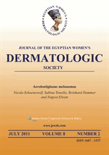
Journal of Egyptian Womens Dermatological Society
Empowering Women's Health Through Dermatological ResearchThe Journal of Egyptian Women's Dermatological Society, published by Wolters Kluwer Medknow Publications, is an essential platform dedicated to advancing the field of dermatology through a valuable focus on women's health issues. Established to provide an open access outlet since 2019, this journal aims to disseminate research, case studies, and reviews that address the unique dermatological needs and concerns of women, particularly in the Egyptian context. Despite its current ranking in the Q4 category in dermatology and a Scopus rank of #117 out of 142 with a 17th percentile, the journal serves a critical role in fostering scholarly communication among researchers, clinicians, and academicians. With a commitment to promoting knowledge advancement and community engagement, this journal invites submissions that align with its objectives, specifically geared towards empirical research and innovative practices in dermatology impacting women's health.
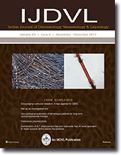
Indian Journal of Dermatology Venereology & Leprology
Elevating Standards in Dermatological and Venereological ResearchThe Indian Journal of Dermatology Venereology & Leprology (IJDL) is a premier open-access journal dedicated to the fields of dermatology, venereology, and leprology, published by SCIENTIFIC SCHOLAR LLC since 2004. With a rich historical background dating back to 1976, the journal has established itself as a reputable source for high-quality research and clinical advancements in these disciplines. The IJDL is recognized for its academic rigor, boasting a 2023 category quartile ranking of Q2 in Dermatology and Q3 in Infectious Diseases, indicating its significant contribution to these fields. With an accessible online platform, researchers, practitioners, and students alike can readily explore the latest studies, case reports, and reviews that address key issues affecting public health, particularly in India and beyond. The journal serves not only as a repository of valuable knowledge but also as a vital forum for the exchange of ideas, fostering collaboration and innovation among professionals dedicated to enhancing skin health and combating infectious diseases.

JOURNAL OF THE AMERICAN ACADEMY OF DERMATOLOGY
Bridging research and practice for dermatology professionals.JOURNAL OF THE AMERICAN ACADEMY OF DERMATOLOGY, published by Mosby-Elsevier, stands at the forefront of dermatological research and education. With an impressive impact factor and categorized as Q1 in Dermatology, this journal has established itself as a pivotal resource for healthcare professionals and researchers in the field. Since its inception in 1979, it has provided a platform for high-quality peer-reviewed articles, contributing significantly to advancements in dermatological science and practice through 2024. The journal commands an honorable position, ranking #8 out of 142 in the Scopus database's medicine dermatology category, placing it in the 94th percentile among its peers. Readers can access a wealth of cutting-edge studies, case reports, and reviews that address a broad spectrum of topics, from clinical dermatology to emerging therapies. In addition, the journal's commitment to excellence ensures it remains an essential tool for students, clinicians, and researchers dedicated to improving skin health and furthering knowledge in dermatology.

Acta Dermatovenerologica Croatica
Pioneering Research for Skin Health and BeyondActa Dermatovenerologica Croatica is a premier journal dedicated to the fields of dermatology and venereology, published by the Croatian Dermatovenereological Society. Established in 1994, this journal has been a vital platform for disseminating research and advancements in the understanding and treatment of skin diseases and sexually transmitted infections. Although it is currently classified in the Q4 quartile for dermatology, infectious diseases, and miscellaneous medicine, it provides a unique opportunity for emerging researchers and seasoned professionals to contribute to a growing body of knowledge. Based in Zagreb, Croatia, the journal emphasizes free access to information that enhances clinical practices and scientific understanding among dermatologists and venereologists worldwide. As the journal approaches its 30th anniversary, it continues to aim for excellence in research quality, fostering collaboration, and innovating in the ever-evolving fields it represents.

AMERICAN JOURNAL OF CLINICAL DERMATOLOGY
Exploring the Frontiers of DermatologyThe American Journal of Clinical Dermatology, published by Adis International Ltd, is a leading peer-reviewed journal dedicated to advancing the field of dermatology. With a notable impact factor and a prestigious Q1 rank in both Dermatology and Miscellaneous Medicine categories, this journal stands out as a valuable resource for researchers and clinicians alike, offering cutting-edge insights into clinical practice and innovative treatment strategies. Its comprehensive scope encompasses a broad range of topics within dermatology, addressing both common and rare conditions, with a focus on emerging therapies and technologies. As it converges its publication years from 2000 to 2024, the journal remains an essential platform for disseminating high-quality research to professionals striving to improve patient care and outcomes. With the ISSN 1175-0561 and E-ISSN 1179-1888, the American Journal of Clinical Dermatology facilitates greater accessibility to pivotal findings within the field, making it an indispensable resource for anyone involved in dermatological research and practice.

JOURNAL DER DEUTSCHEN DERMATOLOGISCHEN GESELLSCHAFT
Exploring the forefront of dermatological discoveries.JOURNAL DER DEUTSCHEN DERMATOLOGISCHEN GESELLSCHAFT, published by Wiley, is a prominent periodical in the field of dermatology, recognized by its Q2 quartile ranking in the 2023 dermatology category. With a dedicated focus on advancing knowledge in dermatological science, the journal publishes rigorous peer-reviewed research that encompasses a range of topics including clinical studies, research methodologies, and innovative treatment practices in dermatology. Its impact is reflected in its Scopus ranking, where it stands at #48 out of 142 in the medicine dermatology category, placing it in the top 66th percentile. Although not an Open Access journal, it serves as a critical resource for researchers, clinicians, and students alike, facilitating the dissemination of high-quality research findings and fostering a deeper understanding of dermatological conditions and treatments. With years of convergence from 2003 to 2024, this journal remains a vital platform for scholarly dialogue and discovery in dermatology.
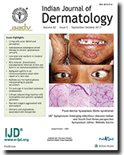
INDIAN JOURNAL OF DERMATOLOGY
Pioneering insights into skin health and disease.INDIAN JOURNAL OF DERMATOLOGY, published by Wolters Kluwer Medknow Publications, is a renowned open-access journal that has been a significant platform for disseminating vital research in the field of dermatology since its inception in 1962. With an ISSN of 0019-5154 and an E-ISSN of 1998-3611, the journal covers a comprehensive array of topics relevant to skin health and diseases, serving both academic and clinical audiences in India and beyond. Having transitioned to an open access model in 2005, it strives to enhance the reach and impact of dermatological research. The journal is classified in the Q3 quartile within the dermatology category as of 2023 and ranks 82 out of 142 in Scopus, showcasing its contribution to the field despite competitive rankings. By fostering scholarly communication and providing a rigorous peer-review process, the INDIAN JOURNAL OF DERMATOLOGY remains a vital resource for researchers, practitioners, and students devoted to advancing the understanding and treatment of skin disorders.
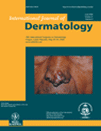
INTERNATIONAL JOURNAL OF DERMATOLOGY
Pioneering insights into skin diseases and treatments.The INTERNATIONAL JOURNAL OF DERMATOLOGY, published by WILEY, stands as a premier scholarly platform in the field of dermatology, with a notable impact factor that affirms its quality and renown. Established in 1963 and converging through to 2024, this journal is recognized as a Q1 category publication, ranking in the top 20% of journals within the dermatology field according to the Scopus ranking system, where it occupies the 28th position among 142 journals. This reflects its dedication to advancing the understanding and treatment of skin diseases, making it a vital resource for researchers, healthcare professionals, and medical students alike. Although it does not provide open access options, articles published in this journal cover a broad range of dermatological topics, ensuring that it serves as a comprehensive and authoritative source for cutting-edge research and clinical practices. With its rigorous peer-review process and commitment to high standards, the INTERNATIONAL JOURNAL OF DERMATOLOGY remains indispensable for those engaged in dermatological science and practice.
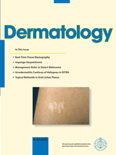
DERMATOLOGY
Fostering collaboration in the pursuit of skin health.DERMATOLOGY, an esteemed journal published by KARGER, is a vital resource in the field of dermatological research and clinical practice. Established in 1893, with its comprehensive coverage extending to 2024, this journal has earned its place as a leading publication, holding a prestigious Q1 quartile ranking in Dermatology and ranking 15th out of 142 in the Scopus Medicine - Dermatology category, reflecting its 89th percentile standing within the discipline. The journal aims to disseminate innovative research findings, critical reviews, and clinical studies that advance the understanding of skin disorders and their treatments. While primarily available through institutional subscriptions, DERMATOLOGY remains committed to enhancing accessibility and fostering international collaboration among researchers, professionals, and students in the dermatological community. Its rigorous peer-review process guarantees the highest quality of published works, making it an essential reference for those dedicated to advancing dermatological science and improving patient care.

Dermatology Practical & Conceptual
Bridging practical insights with groundbreaking research.Dermatology Practical & Conceptual is a prominent open-access journal dedicated to advancing the field of dermatology through the dissemination of cutting-edge research and practical insights. Published by MATTIOLI 1885, this peer-reviewed journal has been committed to open access since 2015, ensuring that valuable information is readily available to researchers, healthcare professionals, and students worldwide. With a focus on innovative and practical approaches in dermatology, as well as its intersections with genetics, molecular biology, and oncology, the journal has established a strong academic presence, achieving a Q2 ranking in Dermatology and notable positions in related fields for 2023. Although its Scopus rankings indicate room for improvement in certain areas, such as genetics and molecular biology, the journal's commitment to quality and accessibility is evident in its engagement with contemporary research trends. The editors invite submissions that address practical challenges and novel methodologies, fostering a multidisciplinary dialogue that enhances dermatological practice and research. The journal operates from its base in Fidenza, Italy, and as it looks toward converged years from 2019 to 2024, it aims to further strengthen its influence and contribute significantly to the dermatological landscape.